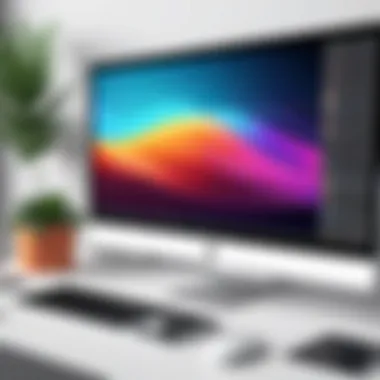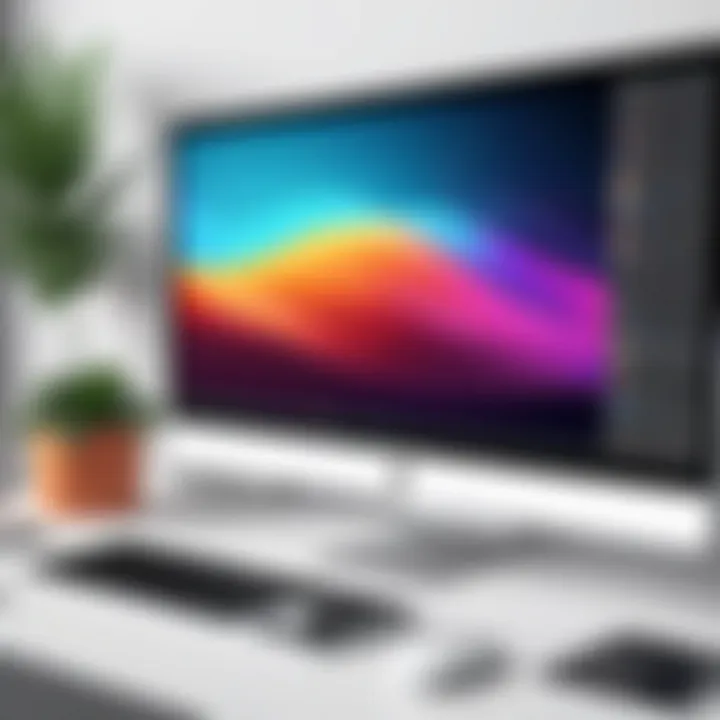Transform Your Photos into Engaging GIFs Easily


Intro
Converting a static photo into a GIF can enhance your digital presentations and social media posts. GIFs allow for more dynamic content, catching the eye of viewers more effectively than still images. With the rise of visual communication, understandig how to create engaging GIFs has become increasingly important for both personal and professional uses.
In this article, we will explore the various methods and tools available for converting photos into GIFs. Additionally, we will provide insights into the technical considerations you may encounter along the way. By the end, you will have a solid foundation in creating GIFs, whether you choose online solutions or dedicated software applications.
Overview of the Technology
To begin, it is essential to understand the principles behind GIF creation. A Graphics Interchange Format (GIF) file is essentially a series of images or frames generated sequentially at a specific rate. Frame rate is a critical factor in the quality of a GIF, as it influences how smooth the animation appears.
Key specifications
- Color Depth: Typically, GIFs support 256 colors, which should be enough for images without gradients.
- Frame Rate: Frame rates can vary from 10 to 30 frames per second (fps), though a common rate is about 24 fps for smooth animation.
- Resolution: Higher resolution allows for more detail but tends to increase file size, affecting the loading time.
Unique selling points
GIFs stand out for their simplicity and compatibility across diverse platforms. Some advantages include:
- Easy Sharing: GIFs can be easily shared on platforms such as Facebook, Reddit, and messaging apps.
- Looping Animation: Unlike videos, GIFs loop indefinitely, providing continuous playback.
- Lightweight Files: They generally consume less bandwidth than videos, making them suitable for web use.
"GIFs combine simplicity with the appeal of motion. Their easy distribution means they are a popular choice for sharing digital content."
Design and Build Quality
While design aspects may not refer to physical products, creating a visually appealing GIF is no less important than the tools used to produce it.
Material used
In the digital context, the material would be the original photo used. Choosing high-resolution images ensures that the final GIF maintains quality.
Ergonomics and usability
Usability revolves around the platforms and software you use for GIF creation. User-friendly interfaces generally provide easier navigation, making the learning curve less steep for new users. Software like Adobe Photoshop and online platforms like Giphy simplify the process by providing intuitive tools that guide you through the conversion.
By understanding these fundamental concepts, you can better navigate the process of GIF-making, enhancing your digital content with animated visuals.
Understanding GIFs
To fully appreciate the process of converting photos into GIFs, it is essential to first understand what GIFs are and their significance in digital visual communication. GIFs, or Graphics Interchange Format files, have been around since the late 1980s and have evolved to become a fundamental component of online content. They allow for short, looping animations or static images compressed in a small file size, making them easy to share across different platforms.
The increasing popularity of GIFs can be attributed to their ability to convey emotions and messages quickly. Unlike static images, GIFs provide a subtle animation that grabs attention. Websites like Reddit and social media platforms such as Facebook utilize GIFs as a preferred format for memes, reactions, and visual jokes. Thus, understanding GIFs is not just about their technical details but also about their cultural relevance and impact on online engagement.
Definition and Characteristics
A GIF is a bitmap image format that supports both animated and static images. Key characteristics of GIFs include:
- Limited Color Palette: GIFs support a maximum of 256 colors selected from the RGB color space. This limitation allows for compression, making the files smaller but can lead to quality loss.
- Transparency: GIFs can have a transparent background, which is useful for overlaying images on various backgrounds.
- Animation Capability: One of the defining features of the GIF format is its ability to create simple animations. A single GIF file can contain a series of images that display sequentially to create the illusion of movement.
Overall, these characteristics make GIFs a convenient format for sharing short animations and enhancing visual storytelling.
The Evolution of GIFs
The journey of GIFs began in 1987 when CompuServe introduced the format, aiming to create a method for transferring images across slow modem connections. Over the years, several key developments have influenced the evolution of GIFs:
- Technical Enhancements: As internet speeds improved, the need for smaller file sizes became less critical, enabling higher quality GIFs with better color depth.
- Cultural Adoption: The rise of social media and meme culture has significantly increased the usage of GIFs. Platforms like Tumblr and Twitter incorporated GIF support, further embedding them into online communication.
- Creation Tools: Various tools emerged to make GIF creation accessible to all users. From simple online converters to advanced software like Adobe Photoshop, these tools have democratized the ability to create and share GIFs.
The evolution of GIFs reflects changing technological landscapes and shifts in online interaction. Today, they are more than just images; they are a means of expression, humor, and commentary.
Why Convert Photos to GIFs
The conversion of static photos to GIFs is an increasingly relevant topic in the realm of digital content creation. This process not only elevates the aesthetic appeal of images but also facilitates a richer viewer experience. By understanding the motivations behind converting photos into GIFs, one can appreciate the broader implications for communication and information sharing. GIFs serve as a hybrid medium that combines the detail and nuance of photography with the kinetic energy of animation. This versatility is essential in today's fast-paced digital landscape.
Enhancing Visual Content


One of the foremost reasons to convert photos to GIFs is the enhancement of visual content. In an environment saturated with static images, GIFs stand out due to their ability to convey more information in a compact format. They allow creators to showcase dynamic elements, such as movement and change, which can be pivotal in storytelling. Furthermore, GIFs can express emotions or reactions in ways that static images cannot, providing a more immersive experience for the audience.
Additionally, GIFs can be tailored for specific contexts—like social media or marketing campaigns—making them exceptionally effective for engaging viewers. When used appropriately, GIFs can draw attention to key messages and ideas, increasing retention and comprehension. Thus, making a photo into a GIF isn't just about movement; it's about enhancing the narrative quality of visual content in a meaningful way.
Engagement and Communication
Engagement is another critical aspect of converting photos to GIFs. In a landscape where attention spans are decreasing, static images may fail to captivate audiences. GIFs can serve as a bridge in communication, illustrating concepts and ideas more succinctly than traditional images. They foster interaction and encourage sharing, which can be particularly advantageous in marketing and branding.
For example, platforms like Facebook and Reddit see higher engagement rates with GIFs. Users often find GIFs relatable and amusing. They can convey emotions quickly, making viewers feel connected. Thus, incorporating GIFs in digital content strategies can significantly improve audience interaction. The ability to communicate effectively through this medium is essential in developing a robust online presence, enabling creators and brands to connect with their audiences on a deeper level.
In today's digital age, using GIFs allows for a more vibrant and interactive communication style, making your visual content stand out.
By recognizing these advantages, tech-savvy individuals and digital creators can leverage GIFs to enhance their visual storytelling and optimize engagement.
Photos vs. GIFs
Understanding the distinction between photos and GIFs is fundamental when considering how to convert static images into dynamic animations. Both mediums serve unique purposes, offering different experiences and functions in visual communication. A thorough grasp of these differences can inform choices about when to use each format effectively.
Static Images
Static images, such as photographs or illustrations, encapsulate a moment in time, presenting a singular visual experience. They are powerful for storytelling, evoking emotions, and capturing details, but their impact can be limited. With no movement or animation, static images rely heavily on composition, lighting, and context to convey a message.
- Clarity and Detail: Static images often possess high resolution, which can highlight intricate details of a scene. This attribute makes them ideal for showcasing products in advertisements or for personal photography.
- Easy Sharing: Sharing a photo is straightforward as it can quickly be uploaded to various social media platforms or sent in emails. There are no complexities, allowing for simple dissemination.
- Usage in Design: In many design contexts, static images are essential. They allow for branding, logo representation, and visual identity that do not require context changes.
While these qualities contribute to the value of static images, the lack of motion can sometimes fall short of engaging audiences fully. They can become less effective over time in retaining user attention, especially in today's fast-paced digital landscape.
Dynamic Visuals
On the other hand, GIFs introduce a level of dynamism that static images cannot achieve. By combining multiple frames into a single file, GIFs create short animations that can convey more complex narratives or emotions. This format has robust advantages, especially in digital communication.
- Enhanced Engagement: GIFs often attract more attention than static images due to their movement. This capability makes them perfect for illustrating concepts or providing visual entertainment.
- Expressive Content: A GIF can convey emotions, reactions, or process sequences in ways that still images cannot. This makes them popular on platforms like Reddit or Facebook, where user interaction is often visual and immediate.
- Versatile Applications: From memes to instructional visuals, GIFs can serve various purposes. They find applications in marketing, learning tools, and social sharing, making them valuable in diverse contexts.
"In a world where information is consumed rapidly, GIFs offer a bite-sized, visually engaging alternative to static imagery."
In summary, while photos and GIFs both play vital roles in visual storytelling, they fulfill different functions. Choosing between them depends on the context, purpose, and desired engagement level. Understanding these elements is crucial as one navigates the creative process of transforming photos into engaging GIFs.
Tools for Conversion
In the realm of transforming photos into GIFs, selecting the right tools is crucial. This section will dive into the various tools available, both online and offline, and outline their benefits and potential drawbacks. Proper tools streamline the conversion process, ensuring that the resulting GIFs are not only visually appealing but also optimized for sharing.
Online Conversion Tools
Overview of Popular Tools
Online conversion tools are often the first choice for many users. They allow for quick access to GIF creation without the need to install any software. Popular tools like Giphy, EZGIF, and Imgflip are user-friendly and cater to various needs.
Giphy excels in integrating social features, allowing users to share their creations directly to social media platforms. EZGIF is highly regarded for its editing capabilities, giving users control over image size and frame rate.
However, while these tools are convenient, they may not offer the same depth of customization that downloadable software provides. Users should weigh the balance of accessibility and functionality based on their specific needs.
Workflow for Using Online Tools
Using online tools typically involves a straightforward workflow. First, users upload their selected images, adjust any settings like speed or size, and then initiate the conversion process. Most online platforms have intuitive interfaces, making this process quite simple.
A common characteristic of these online platforms is their immediacy. Users do not need to download large files, and they can generate GIFs quickly. However, one should consider potential upload limits and internet connectivity, which may cause delays in the conversion process, especially with large files.
Downloadable Software
Features of Leading Software
Downloadable software like Adobe Photoshop and GIMP provides advanced functionalities that cater to users who prefer comprehensive control over their GIF creation process. These programs offer extensive editing options that ensure polished results.
For instance, Adobe Photoshop allows users to create frame-by-frame animations and fine-tune every aspect of the GIF, including color settings and timing. GIMP, being open-source, provides a good alternative with powerful tools at no cost. Users who require professional-level quality often favor these applications.


However, with advanced features come a steeper learning curve. Users should be prepared to invest some time in learning how to effectively utilize these tools.
Installation and Setup
Installation of downloadable software is generally straightforward. For example, Adobe Photoshop requires users to purchase a license and download the installer from their official website. Once downloaded, installation is usually just a matter of clicking through the setup prompts.
A key characteristic of this software is its ability to work offline, providing a consistent user experience without reliance on internet access. However, heavy software like Photoshop requires a more powerful computer system, which may exclude some users. Understanding the system requirements before installation is essential to ensuring a smooth experience.
"Choosing the right tool for GIF creation often depends on your level of expertise and specific needs."
Navigating between online tools and downloadable software allows users to tailor their GIF creation process to their preferences, skills, and project requirements. Both options have valuable characteristics that can accommodate different preferences in the quest to convert photos to GIFs.
Step-by-Step Guide to Create a GIF
Creating a GIF from a photo can be straightforward, yet it encompasses several crucial steps. This guide aims to illuminate each part of the process, ensuring that the technical aspects are clear while maximizing the aesthetic appeal of the final product. Understanding how to properly create GIFs not only enhances your visual arsenal but also enables you to better communicate ideas and feelings through animated content.
Selecting the Right Image
The first step in making a GIF is choosing the image you want to animate. The right image serves as the foundation for your GIF. Consider these factors while making your selection:
- Subject Matter: Choose a photo that is engaging and has the potential to tell a story or convey emotion. Vibrant or dynamic images work well, as they capture attention quickly.
- Resolution: Higher resolution images generally result in better quality GIFs. However, consider the balance between quality and file size, which can impact loading times.
- Composition: Images with clear focal points and minimal distractions usually make better GIFs. Ensure that the main element is prominent to maintain viewer interest.
Choosing the GIF Creation Method
Once you have selected an image, the next essential step is deciding how to create the GIF. Several methods exist, each with its own benefits:
- Online Tools: Websites such as Giphy and Imgflip offer user-friendly interfaces that allow for quick conversions. These tools typically provide simple functions tailored for those who prefer ease of use.
- Software Applications: Programs like Adobe Photoshop or GIMP enable more advanced editing capabilities. These tools allow you to control every aspect of the GIF-making process but may require a learning curve.
When choosing a method, consider your comfort with technology and the level of detail you want to achieve. For quick projects, online tools suffices, but for intricate or professional needs, software applications can provide more intricate controls.
Editing and Customizing the GIF
The final step involves editing and customizing the GIF to fit your vision. This stage is where creativity can truly flourish:
- Trimming: Cut any unnecessary parts of the image that do not add value. Focusing on key elements increases impact.
- Adding Effects: Applying filters or effects can enhance the visual appeal. Something as simple as adjusting brightness or contrast can significantly transform the image.
- Text Overlays: Adding text can provide context or convey an additional message. Ensure the font is legible and complements the overall design.
- Speed Adjustment: Depending on the message you want to convey, adjusting the speed of your GIF can change how viewers perceive the content. Faster GIFs might evoke excitement, while slower ones can create more emotional resonance.
Each of these elements contributes to the final quality and effectiveness of your GIF, making it essential to pay careful attention during this phase. By implementing thoughtful editing practices, you can create a GIF that not only represents your image well but also resonates with your audience.
File Size Considerations
When transforming a static photo into a GIF, understanding file size considerations is crucial. It influences not only the performance of the GIF but also the viewer's experience. Larger files might lead to longer loading times, which can deter viewers. In contrast, files that are too small may compromise image clarity, resulting in a subpar visual experience.
Impact of Image Quality
The impact of image quality on file size can be significant. GIFs often face restrictions in color palette, as they support only up to 256 colors. This limitation impacts how well a photo can translate into GIF format.
Higher quality images usually have more colors and details. During the conversion process, dithering techniques are often used to maintain a semblance of color variety. However, this can increase the file size. To ensure acceptable quality while managing file size, one must select images that strike a balance. A well-detailed source image can yield better visual results, but one must remain vigilant regarding added file weight.
Balancing Size and Quality
Balancing size and quality requires focused attention on the methods applied during the creation of the GIF. Here are a few strategies:
- Optimize Image Dimensions: Reducing the pixel dimensions of the image before conversion can help decrease file size.
- Limit Frame Rate: Often, the number of frames per second must be controlled. Fewer frames mean smaller file sizes but may also result in choppy animations.
- Use Compression Tools: Many tools available for GIF creation include options to compress the file after it is completed. Though this can lead to quality loss, it can also ensure the GIF is more compatible with platforms like Reddit or Facebook.
In summary, being aware of file size considerations helps users create more effective GIFs. The decisions made regarding image quality directly influence the final product's usability and reach.
Post-Creation Tips
Creating a GIF from a photo is just the beginning of the process. Post-creation is crucial for ensuring your GIF is effectively utilized and reaches your intended audience. Proper management after creation can enhance both visibility and impact.
Exporting and Sharing GIFs
When it comes to exporting your GIF, choosing the right format and quality settings is key. Most software allows you to save your creation in various formats. Selecting the standard GIF or optimizing for web use can make a difference in the file size and loading time. Here are a few tips for exporting:


- Dimensions: Ensure your GIF is sized for where it will be used. A social media post may need different dimensions compared to an email attachment.
- Resolution: Consider the resolution. Higher resolution gives better detail but can result in larger file sizes. Balancing this is important.
- File Name: Name your GIF clearly, using descriptive keywords that relate to the content. This helps in searchability on the web.
After exporting, sharing your GIF effectively increases its reach. Platforms like Reddit or Facebook provide options to upload and share GIFs easily. Uploading it to your desired platform can involve different steps, such as:
- Direct upload: Many platforms allow direct uploads. Just select your GIF file from your device.
- Link sharing: If hosted elsewhere, you can share a link to your GIF instead.
- Embedding: Some sites offer HTML embedding codes, useful for blogs or personal websites.
Utilizing GIFs on Social Media
Social media is a potent avenue for using GIFs. They can capture attention quickly and engage viewers in ways that static images often cannot. Here are some best practices to keep in mind:
- Platform Compatibility: Different social networks have varying GIF policies. For example, Twitter and Facebook support direct uploads, but others may have restrictions. Understand the platform's allowances.
- Timing and Relevance: Use your GIF in appropriate contexts—this ensures it resonates with the audience. For example, a celebratory GIF on New Year’s posts can drive engagement.
- Hashtags: Use relevant hashtags to categorize your GIF. This makes it easier for users to find your content.
Remember: Engaging content is often shared, facilitating organic growth and broadening your audience reach.
Common Challenges
When converting photos into GIFs, several common challenges can arise. Addressing these issues will contribute to smoother creation processes and higher quality outcomes. Understanding the implications of these challenges is crucial for those who wish to effectively convert and utilize GIFs.
Quality Loss
One of the most frequent difficulties encountered in GIF conversion is the loss of image quality. The compression algorithms used to create GIFs often result in a reduction of color depth and resolution. This occurs because GIFs typically support a maximum of 256 colors per frame, which may not capture the full detail of a photograph. When high-resolution images are converted, the result might appear less vibrant or sharp than the original photo.
To minimize quality loss, it is advised to start with higher quality images. Using lossless formats, like PNG, before conversion can also help. Additionally, employing advanced software tools that allow for fine-tuning of settings can help optimize the final output.
Technical Issues
Another significant challenge involves potential technical issues during the conversion process. These can range from software incompatibilities to unexpected errors within the conversion tools. For instance, some online platforms may not handle large files well, potentially leading to crashes or failed conversions.
Users should be aware of the specifications of their chosen software or online tool. Knowing the supported file types, size limitations, and resolution rules can prevent these problems from occurring. Regular updates of software further ensure that users have the latest bug fixes and enhancements.
As much as technicalities can impede creativity, understanding and preemptively addressing these challenges can lead to a more successful GIF creation process.
Future of GIFs
The landscape of digital communication is everevolving, and the future of GIFs is no exception. As a form of visual content that bridges the gap between static images and full-length videos, GIFs are particularly relevant in modern digital expression. They are not just fun animations; they can convey emotions and humor effectively, making them a potent tool for communication.
Technological Advancements
Technological advancements are pivotal in shaping the future of GIFs. As internet speeds increase and device capabilities improve, the potential for richer, more complex GIFs grows. Algorithms are becoming more sophisticated, allowing for better compression techniques without significant loss of quality. This advancement means that larger and higher-quality GIFs can be shared more easily than before.
- Enhanced GIF Creation Tools: Software like Adobe Photoshop and online platforms like Giphy are innovating, making GIF creation easier and more accessible.
- AI Integration: Artificial intelligence is starting to influence GIF design. For instance, AI can help in extracting short sequences from videos automatically, simplifying the creation process.
"Technological enhancements in GIF-making tools bring versatility, enabling users to create unique content with less effort."
As we look ahead, the focus on optimization will likely continue, enabling GIFs to be used in ways we have yet to fully realize.
Cultural Relevance
The cultural relevance of GIFs in the digital age cannot be overstated. They have become a staple in online communities, often used for sharing reactions on platforms like Reddit and Twitter. The ease with which users can access and distribute GIFs turns them into a universal language of sorts.
- Memes and Pop Culture: GIFs are often connected to memes, providing an additional layer of meaning. This connection encourages cultural exchange, as memes often reflect contemporary societal issues or trends.
- Changing Communication Norms: As communication shifts towards visual over textual expression, GIFs represent this change in how we interact. GIFs can encapsulate ideas and emotions quickly, fitting the fast-paced digital culture.
In sum, the future of GIFs appears bright, driven by ongoing technological innovations and their integral role in online communication. As they adapt and evolve, GIFs will likely continue to be central in how we express ourselves in the digital world.
Finale
The conclusion serves a vital purpose in this article as it encapsulates the journey through the intricate process of creating GIFs from photos. It not only summarizes the key insights but also emphasizes the significance of understanding this medium in today’s digital landscape. As we transition from static images to animated formats, the need for comprehension surrounding these conversions becomes apparent.
One essential point to highlight is the versatility of GIFs. They bridge the gap between still imagery and full motion video, enabling creators to express ideas dynamically. This adaptability makes GIFs a powerful tool for communication, especially on social media and digital marketing platforms.
Additionally, understanding the tools and techniques discussed throughout the article facilitates a smoother workflow for users. From online conversion tools such as Giphy to downloadable software like Photoshop, each option provides distinct advantages, depending on the user’s requirements and technical skills.
Moreover, addressing the common challenges associated with GIF creation—such as quality loss and technical issues—equips readers with the knowledge to navigate these obstacles effectively. This expertise fosters creativity without compromising the quality of the output.
In summary, the ability to transform photos into engaging GIFs not only enhances visual content but also encourages better engagement with audiences. The insights shared in this article aim to empower users with practical skills, ensuring they can adeptly harness this art form to amplify their digital presence.
Recap of Key Points
- Understanding GIF importance: GIFs offer a unique blend of characteristics that facilitate creative expression in digital communications.
- Conversion tools: Various tools exist, both online and offline, catering to different levels of expertise and needs.
- Technical considerations: Quality management and file size optimization are key to maintaining visual integrity in conversions.
- Challenges: Familiarity with potential issues related to GIF creation enables users to troubleshoot effectively, enhancing their overall experience.
- Future viability: GIFs continue to evolve, reflecting cultural relevance and technological improvements, ensuring their position in modern content creation.







